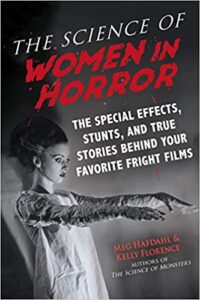The Science of Women in Horror: The Special Effects, Stunts, and True Stories Behind Your Favorite Fright Films by Meg Hafdahl and Kelly Florence
Skyhorse Publishing, 2020
ISBN-13: 9781510751743
Available: Paperback, Kindle edition ( Bookshop.org)
The Science of Women in Horror explores theories behind women’s roles in horror. The book is broken down into ten sections, each containing well-researched film analyses and interviews with women working in the horror industry. Themes discussed are: the mother; the final girl; sex; revenge; innocence; the Gorgon; healer; and hysteria. The authors also include sections on films regarding women as “invaders” into masculine territory, women who kick ass, endnotes, and an index. All of the sections present fundamental and compelling analyses, but I will highlight some of the best sections in this review.
In “The Mother,” the authors took a closer look at Alice Lowe’s film Prevenge through the lens of mental health, revenge, and mothering; The Babadook and mothers who don’t form bonds with their children, even murdering their own offspring; and the Bates Motel series regarding overbearing mothering. Included in this section are interviews with Alice Lowe regarding her film, and Dee Wallace on portraying mothers or caregivers in horror films.
“The Final Girl” section breaks down the history of the concept of the final girl and A Nightmare on Elm Street, with a portion of the chapter devoted to The Shining’s Wendy Torrance as final girl that could have been its own chapter. The first non-white final girl, from Tales from the Crypt: Demon Knight gets her own chapter in this section. The last chapter includes an analysis of the 2018 Halloween and the urban legends of babysitters in horror and how it is explored in horror films. The authors also discuss how Jamie Lee Curtis approached her role, in that Laurie never received treatment for PTSD, and how she addresses her mental illness in the future, as well as the concept of transgenerational trauma addressed in the movie. Interviews in “The Final Girl” include Jenna Kanell on physicality in her roles (she does her own stunt work) and Ashlee Blackwell, who started the incredibly informative Graveyard Shift Sisters blog and the documentary Horror Noire.
In the section regarding “Sex,” the authors explore Sleepaway Camp and representation of transgender characters, with interviews with Stacey Palmer regarding the representation of transgender women in horror films, and Alice Schroeder about being a trans woman working in theatre and portraying Frank N. Furter in Rocky Horror Picture Show. In the chapter about the film Teeth, purity culture, rape culture, and women frequently punished for indulging in sexual activity are presented. Finally, sexual assault and marital rape are looked at in Gerald’s Game.
“The Innocent” section takes a closer look at some of my favorite horror films. Themes include Let the Right One In and female innocence; Beetlejuice, and a great discussion of all things Lydia; and Whatever Happened to Baby Jane? in terms of trauma and extreme action.
“The Gorgon” introduced me to two new terms in the horror subgenre: psychobiddy and hagspoitation. Discussed in this section are Drag Me to Hell, The Visitation, and Friday the 13th. Included is an interview with Aislinn Clark about single or unmarried mothers in horror.
“Women in a Man’s World” focuses on the remake of Ghostbusters and the backlash that occurred even before the trailer was released; the influence that Scully from the X-Files had on the STEM field; and discussion of woman as monster in Ginger Snaps.
The Science of Women in Horror provides a great basis for discussion on horror and social sciences. I would recommend this for gender and/or film studies courses, as well as for the general horror reader who wants to gain a deeper understanding of films in their favorite genre. Highly recommended.
Reviewed by Lizzy Walker
Editor’s Note: The Science of Women in Horror: The Special Effects, Stunts, and True Stories Behind Your Favorite Fright Films is a nominee on the final ballot for the 2020 Bram Stoker Award for Superior Achievement in Nonfiction.





Follow Us!